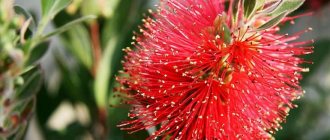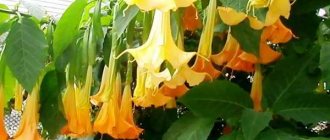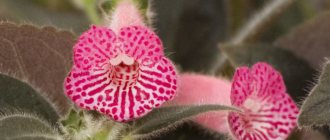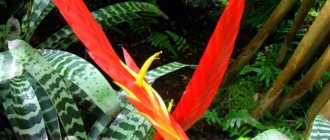Achimenes - a beautiful flowering perennial shrub
Achimenes (photos and videos of this amazing flower are widely presented on all websites of home floriculture lovers) is a herbaceous perennial plant with spreading and creeping stems, which attracts with its bright, stable and abundant flowering. The flowers are bell-shaped, funnel-shaped, elongated, of various bright colors, depending on the variety: violet, carmine, blue, white, coral, dark and light pink, white, red, red-violet, with inclusions, spots and stripes. The leaves are oval, slightly shiny, with oval edges, pubescent, thin, sometimes with a reddish lower surface; some varieties have bronze leaf blades.
At home, Achimenes often bloom twice per season.
The plant’s homeland is tropical and Central America, where there are about 40 species of Achimenes, but at home the most popular are:
- long-flowered Achimenes - an ampel-shaped flower, medium-sized (up to 30 cm in height), with narrow, light green leaves, slightly pubescent. The flowers are solitary, up to 5 cm in diameter, coloring is white, yellow or purple with stripes near the throat. Popular varieties - Major , Juaregia , Chiapas , Haage
Snow-white Achimenes "Juaregia"
Beautiful purple Achimenes 'Major'
- Achimenes grandiflora is the largest representative, can reach a height of up to 65 cm, with spreading, heavily pubescent shoots and dark green leaves with a reddish tint at the edges. Flowers with a diameter of 5-7 cm, colors: pink, white, blue, carmine-red, carmine-pink, red-violet, a characteristic difference is that there is a bag-like swelling at the base of the flower. Popular varieties: Little Beauty , Yellow Beauty , Paul Arnold , Cattleya, Purple King .
Bright achimenes "Little Beauty"
Achimenes 'Paul Arnold' with a beautiful combination of purple buds and dark double leaves
Ahimsenes "Yellow Beauty" with beautiful creamy buds
Lighting
Despite the fact that in general Achimenes is a light-loving plant, the brightness and intensity of the light flux largely depends on the plant variety. Varieties with dark leaves need more light than variegated varieties, but Achimenes do not tolerate direct sunlight. At noon, the plant must be shaded - this will help avoid burns on the leaf blades.
Achimenes cannot be considered too capricious a houseplant
Achimenes are very popular among house plants.
Brief description of the flower
Breeders have invented a large number of species of this beautiful plant. All of them bloom thickly and luxuriantly, pleasing the eye with incredibly bright flowers of unusual shape. In appearance, Achimenes is a low-growing flower with a straight and thin stem, which begins to droop over time. The leaves have a jagged shape, similar to nettles. The flowers themselves look like elongated bells. They have many colors: red, pink, purple, white, yellow.
Achimenes flower
Temperature
For normal development of achimenes, the temperature should not be lower than 20 °C, optimally 22-23 °C. It does not tolerate sudden changes in temperature and cold drafts. In summer, it can be taken out to the balcony only if there are no large fluctuations in daily temperature (cold nights). With the onset of autumn, before the onset of the dormant period, the temperature begins to decrease.
The variety of shapes and colors of Achimenes never ceases to amaze
Large-flowered
Of all varieties - the largest. The height of the bush can reach 60 cm. Flowers with a diameter of up to 6 cm are drowned in abundant foliage.
The most detailed description of achimenesa of one type or another can be found in online catalogs.
Humidity
For successful cultivation of achimenes at home, the humidity level is of great importance, which should be at least 60%. And the higher the temperature gets, the higher the humidity indicator should become. At the same time, spraying is strictly contraindicated for Achimenes - after droplets of moisture get on the flower or leaves, black or brown spots form on them. Therefore, a wet cloud is created not above the flower, but next to it. As an option, install an aquarium nearby, or even better, place the pot in a tray with damp expanded clay or moss (sphagnum), but the bottom should not be in direct contact with water.
Achimenes do not tolerate low humidity
In order for a plant to please you with its flowering, you need to create favorable conditions for it.
Diseases and pests
If you carelessly care for a plant, it will be plagued by diseases and pests, as evidenced by unpleasant symptoms:
- spots on the leaves of Achimenes - from watering with cold water or excess sunlight (adjust watering, shade the plant);
- Achimenes flowers quickly fall off - excess light (move to the shade);
- Achimenes is deformed, leaves of Achimenes fall off - damage by pests (insecticides are used);
- Achimenes leaves turn yellow - decreased photosynthesis due to iron deficiency or watering with hard water (feed with fertilizer containing iron; settle water for irrigation, soften with citric acid - 0.2 g per liter of water);
- the leaves are brown and curl - a sharp change in temperature, keeping the plant in a cool, damp room (move to a dry, warm place, protected from drafts and temperature changes).
Achimenes is sometimes affected by pests: aphids, mealybugs, thrips, spider mites.
Rest period
With the onset of autumn, with the end of flowering, the plant begins to prepare for the dormant period. By this time, fertilizing the plant is stopped and watering is sharply reduced. Leaves stop growing, turn yellow and die, nutrients and moisture accumulate in the roots. When the above-ground part of the plant dries out (the roots will draw out all the useful substances from it), it must be cut off and the tubers left in a pot or placed in sand. The pot with tubers is placed in a cool, dark (14-16 degrees) place. Watering is carried out with settled warm water once a month, very carefully, along the edge of the pot, only slightly moistening the earthen ball - excess moisture can provoke premature awakening of Achimenes from sleep.
Advice! If the plant still awakens ahead of time, it should be provided with a lot of light using daylight lamps for plants - this will help the normal development of the stems.
Variety “Double Pink Rose” with a soft pink tint
Spectacular bush with ash-burgundy buds
At the end of February, the pot with rhizomes is transferred to a warmer (above 16 ° C) and bright room. If the roots were stored in sand in winter, they must be planted in pots with substrate.
Varieties of Achimenes
Primrose fine-toothed - how to grow at home
Today you can find several types of plants and a huge number of different varieties. The most popular varieties:
- Achimenes grandiflora (Achimenes qrandiflora). Its homeland is Mexico. It is considered the largest flower of all species and can reach a height of up to 65 cm. It is not difficult to grow. The leaves are large, reaching 10 cm in length and up to 7 cm in width. Flowers grow in batches, and several shoots may appear from one cavity. Their main color is purple.
- Long-flowered Achimenes (Achimenes lonqiflora). This is a medium-sized plant with an ampelous shape. It grows up to 30 cm in height and has a scaly underground root. The leaves are light green, slightly pubescent, long in shape, with a serrated edge. Large flowers. The color is white, yellow, or purple with a stripe near the throat.
- Achimenes Juareqia. White ampel with large flowers, reaches 6 cm in diameter. Achimenes Juareqia creates beautiful cascades and is characterized by active development and flowering.
- Sweet Achimenes (Achimenes dulcik). The plant is medium in size, has straight shoots and large light green leaves. The flowers are white and bell-shaped, with petals slightly curled to the outside. The pharynx is extensive, in the middle there is a lemon-colored spot with small brown drops. It has a very weak, light and pleasant aroma.
- Achimenes erecta. This type of flower reaches a size of up to 40 cm. It has red shoots and flowers with a diameter of 1 cm. Red Achimenes has thick and lush leaves.
Flower varieties
- Mexican Achimenes (Achimenes mexicana). It reaches a height of up to 50 cm. The size of the flowers is medium violet-blue, the corolla is bell-shaped, there is a white spot in the middle, and a yellow stripe on the throat. Achimenes violet has large straight shoots with lush emerald leaves.
- Achimenes Misera. This is a medium-sized plant, the flowers are white, reaching 1 cm in diameter. The leaves are small, dark green, densely located on an erect column.
- Snow-white achimenem (Achimenes candida). This plant has snow-white flowers, very rarely with a hint of yellow. It has a funnel shape. The leaves are jagged at the edges, and the shoots are rough and dark red in color.
- Achimenes antirrhina. This type of achimenes has medium-sized flowers, with a yellowish corolla, on which a rich red pattern can be seen. Light green leaves are covered with white fibers.
Landing
Rhizomes that have overwintered in the sand are replanted (or replanted) in early February. Achimenes is not very picky about the quality of the substrate, the main thing is that the soil is very loose and slightly acidic. The catalog for gardeners recommends a soil mixture for growing Saintpaulia, which must be diluted with garden soil and vermiculite (leaving powder), coco soil or sphagnum. You can prepare the soil yourself by mixing sand, turf and leaf soil in equal proportions, and the obligatory condition is to create powerful drainage.
Gorgeous variety "Kohleria Flowers"
Planting is carried out in a wide, shallow pot - Achimenes rhizomes grow almost on the very surface of the soil (photo 1), the entire root system of the plant is located on top. If the pot is too deep, then all the unused soil in the “depth” may turn sour, further provoking rotting of the entire root system.
Photo 1. Planting rhizomes
To form a strong, overgrown bush, up to 15 tubers are planted in one pot with a diameter of 20 cm. Rhizomes (tubers) are placed on the surface of the soil mixture and pressed down a little, after which watering must be carried out from below - top watering can lead to the fact that the rhizomes can go even deeper into the soil, as a result, germination will slow down significantly. As the shoots appear and grow, gradually add 1-1.5 cm of soil. The planting process is presented in detail in the video at the end of the article.
Young Achimenes bush
Advice! In the future, when the rhizome grows, it is better to transfer the plant to a larger (wider) pot.
Table: how do care errors manifest themselves and what to do to correct the situation?
| Problem | What caused it? | How to fix the situation? |
| Gray fluffy coating on leaves, stems and buds. | Appears when overwatering or too high humidity. This often happens if you leave achimenes outside in cool and rainy weather in the summer. | Bring the plant into your apartment. Limit watering. Remove the top layer of substrate and add new soil. Treat the soil with any fungicide according to the instructions. |
| Flowering is not abundant, flowers are small. | There are not enough microelements in the soil, especially potassium. | Feed with complex fertilizer. |
| Dry brown spots on leaf blades, buds crumble. | The plant received sunburn. | Remove damaged leaves, shade the flower from direct sunlight with tulle or move it to another place with diffused light. |
| Brown edges and tips of leaves. | The indoor air is too dry. | Place sphagnum moss or pebbles in the tray and moisten periodically. Spray the air around the plant; in hot and dry weather this should be done almost daily. |
| The leaves curl. | Watering too much or the volume of the pot does not correspond to the size of the plant (container is too large). | Transfer the achimenes into a small container and reduce the amount of watering. |
Interesting facts about the plant
It is Achimenes that is called the “magic flower” for its beauty. This is a plant that pleases the gardener with long and beautiful flowering. In his genus, according to various sources, there are from 35 to 50 species of perennial tuberous and rhizomatous herbaceous plants growing epiphytically in tropical forests of both hemispheres - in Central and South America (Brazil, Mexico, Guatemala, Uruguay, Colombia, Panama, Paraguay, Argentina , Jamaica).
The name of the genus comes from the Greek words “a” - “not” and “heimaino” - “tolerate cold”, i.e. “does not hibernate”, “intolerant (afraid) of cold”, as if telling us that the plant dies off in winter. The people have another name for Achimenes - “twisted carp”, which speaks for itself.
The first mention of Achimenes dates back to the middle of the 18th century, when Achimenes erecta (A. erecta) was described in 1756 by Patrick Brown while studying the nature of Fr. Jamaica.
Reproduction
Achimenes is propagated using the following methods:
- cuttings;
- division by rhizomes;
- growing seedlings from seeds.
The order of flower propagation by cuttings:
- Prepare a small container filled with washed river sand.
- Moisten the substrate.
- Cut off the top of the shoot 5-6 cm long.
- Stick the bottom of the stem into the sand and cover it with a plastic bottle with the bottom cut off and the lid open (for ventilation).
- Place the container in a warm and well-lit place.
- When the sand dries, moisten it without removing the bottle.
With this method of propagation, roots appear in about 2 weeks. Then the cutting can be planted in a permanent pot.
Advice! Remove the emerging buds from the rooted cuttings. They will slow down the growth of the plant, and it will be weak and frail. Allow it to bloom after the bush has grown lush and strong.
To propagate Achimenes using rhizomes, you need to wait for transplantation. Separate several tubers and plant them in a separate pot. This way you can get several new plants at once.
Planting Achimenes seeds (step-by-step instructions):
- Pour river sand into a bowl and moisten it.
- Place the seeds on top and press them lightly with your palm.
- Cover the container with film and place it in a warm and well-lit place. The optimal temperature for seed germination is +24…+26 °C.
- Periodically moisten the sand with a sprayer and ventilate the greenhouse.
- After the shoots emerge, remove the film.
- Moisten the sand until the 3rd true leaf appears.
- Plant the seedlings in individual containers using the same soil as for adult plants.
- When the seedlings begin to outgrow the cups, transplant them into individual permanent pots and continue to care for them as adult plants.
It is better to propagate Achimenes by seeds in late February or early March. Reproduction by dividing rhizomes is carried out at the end of February during transplantation. But it is better to start cuttings in late spring or early summer.











